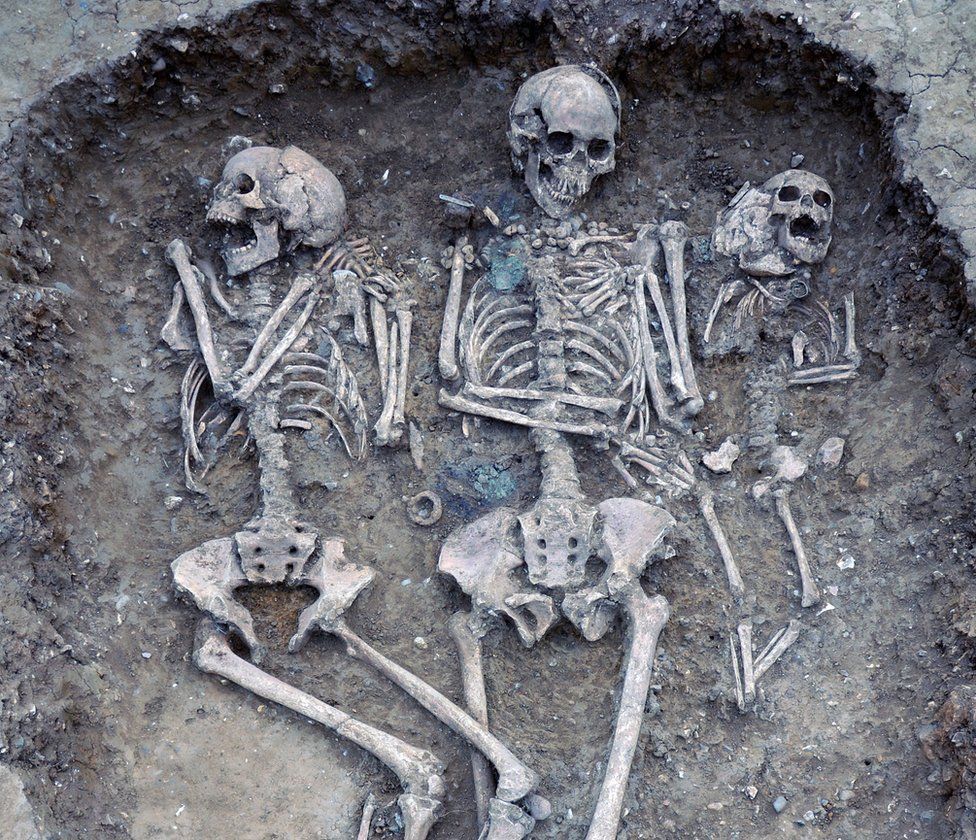English DNA 'one-third' Anglo-Saxon
- Published

The present-day English owe about a third of their ancestry to the Anglo-Saxons, according to a new study.
Scientists sequenced genomes from 10 skeletons unearthed in eastern England and dating from the Iron Age through to the Anglo-Saxon period.
Many of the Anglo-Saxon samples appeared closer to modern Dutch and Danish people than the Iron Age Britons did.
The results appear in Nature Communications journal.
According to historical accounts and archaeology, the Anglo-Saxons migrated to Britain from continental Europe from the 5th Century AD. They brought with them a new culture, social structure and language.
Genetic studies have tackled the question of Anglo-Saxon ancestry before, but sometimes gave conflicting results.
Confounding factors included the close genetic affinities of people in North-West Europe and the scarcity of ancient DNA from indigenous Britons and the Germanic-speaking migrants.
Dr Stephan Schiffels of the Max Planck Institute for the Science of Human History in Germany sequenced genomes of human remains from Hinxton, Saffron Walden, Linton and Oakington - all of which are near Cambridge.
The burials fall into three different age categories: Iron Age, early Anglo-Saxon and Middle Anglo-Saxon.
Contrary to narratives suggesting large-scale displacement of the Britons by Anglo-Saxon invaders, the researchers found evidence of intermarriage in the earliest phase of settlement.
In order to disentangle the Anglo-Saxon signal from the indigenous British genetic background, the researchers looked at many rare mutations across the whole genome.
"We found that these rare mutations were the key to studying historical samples. We could compare our ancient samples with modern samples in an improved way," Dr Schiffels told BBC News.
"We could look at these in a very large sample of modern Europeans. For example, we studied low frequency mutations that must have occurred in the ancestors of the Dutch over the last few thousand years.
"We found that these mutations were shared with the Anglo-Saxon immigrants at a factor of two more than they are with the indigenous Celtic people. These rare mutations are found only with whole genome sequencing."
From there, the scientists could track the contribution made by those Anglo-Saxon migrants to modern British populations.
They found that on average 25%-40% of the ancestry of modern Britons is attributable to the Anglo-Saxons. But the fraction of Saxon ancestry is greater in eastern England, closest to where the migrants settled.
Even traditionally Celtic populations, such as the Welsh and Scottish show some Anglo-Saxon-like ancestry - even though it is typically lower than that in eastern England. But Dr Schiffels points out that it is difficult to tell when this genetic component arrived there until DNA from Iron Age remains in those regions is analysed.
In another study, also published in Nature Communications, Prof Dan Bradley from Trinity College Dublin and colleagues analysed the genomes of nine individuals from Roman-era York.
They found that six of the individuals - presumably indigenous Britons - were similar to the modern Welsh, but different from populations living in Yorkshire today.
However, one of the individuals had genetic affinities with people from North Africa and the Middle East, providing evidence of long-scale migration in Roman times.
The burials at Driffield Terrace, from which the genetic data was drawn, fit the profile of Roman gladiators.
The majority were male, under 45 years old and had been decapitated. They were also slightly taller than the average for Roman Britain, with most showing signs of trauma to their bones.
However, Prof Bradley and his colleagues point out that the remains might also be compatible with Roman legionaries.
Follow Paul on Twitter.